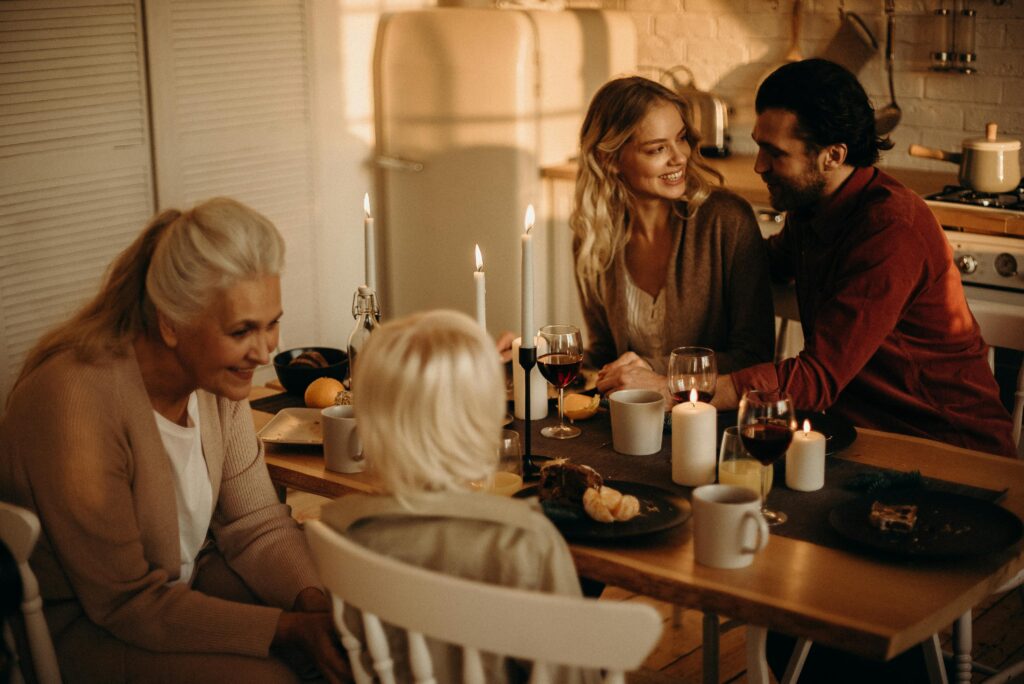Thanksgiving isn’t just about the food—it’s about the feeling. The laughter, the stories, the quiet comfort that comes from gathering in a space that feels alive yet relaxed. But while most of the attention goes to the dining table, the real heart of the celebration often ends up being the living room. It’s where people linger long after dessert, curl up for movies, or have those spontaneous, unforgettable conversations.
Designing a living room that hosts beautifully—without sacrificing style—takes more than just good taste. It’s about flow, warmth, and intention. Here’s how to create a space that’s as ready for guests as it is for gratitude.
Contents
1. Start With Flow, Not Furniture
The key to great hosting is easy movement. Before you think about decorations or even color palettes, think about how people will move through your space.
If your living room will host several guests, rearrange your furniture to encourage conversation. Create small seating clusters rather than one big layout. A sofa facing two armchairs, with a soft rug underneath, forms an instant gathering zone.
Make sure there’s enough walking space between furniture pieces so people can move freely (especially with plates and drinks in hand). And don’t be afraid to temporarily move pieces that block flow—like a coffee table that’s too large or a side chair that feels cramped.
Your goal: a layout that feels open, but still cozy.
2. Layer Your Lighting for Warmth and Mood
Lighting can make or break the atmosphere, especially during the holidays when the sun sets early. Avoid relying solely on overhead lights—they tend to flatten a room and wash out warmth.
Instead, create layers:
- Ambient light (lamps and dimmers) for general brightness.
- Accent light (candles or fairy lights) to add warmth and sparkle.
- Task lighting (reading lamps or wall sconces) for functional glow where needed.
Use soft white or warm amber bulbs instead of cool white ones. They mimic natural firelight and give your space that golden Thanksgiving glow.
And if you want your space to feel instantly more inviting? Turn off the overhead lights and let the lamps do the work.
3. Create Texture Through Textiles
Nothing says “welcome” like texture. It softens a space, adds depth, and invites touch—the ultimate cue for comfort.
Start with your anchor pieces: rugs, throw blankets, and cushions. Mix materials: a wool rug underfoot, velvet pillows on the sofa, and a chunky knit draped over an armchair. If your color palette leans neutral, this is where you can play with pattern—think plaid throws or subtle metallic accents for the holidays.
Textiles aren’t just aesthetic; they’re functional too. Extra blankets and floor cushions make it easy for guests to settle in and stay awhile.
4. Add Conversation Starters, Not Clutter
Great hosts know that design can spark connection. Include elements that invite curiosity or emotion—a well-placed coffee table book, a sculptural vase, or an heirloom bowl filled with seasonal decor.
For Thanksgiving, you can skip the over-the-top decorations. Instead, add natural elements like pinecones, dried flowers, or small pumpkins in muted tones. They bring the season indoors without overwhelming your space.
If you have a fireplace, style your mantle with intention: a few candles, greenery, or framed photos from holidays past can make guests feel right at home.
5. Scent and Sound: The Finishing Touches
Hosting isn’t just visual—it’s sensory. A subtle scent can define your atmosphere just as much as lighting or décor. Opt for warm, inviting notes like cinnamon, cedarwood, or vanilla. You can use a diffuser, candle, or even simmer a pot of orange peels and cloves before guests arrive.
Music matters too. Create a playlist that evolves with the evening—soft jazz or acoustic tunes during dinner, then more upbeat tracks as the night winds down.
These details don’t shout “design”—they whisper “welcome.”
6. Make It Personal
The most stylish rooms still feel personal. Add elements that reflect your life: a framed family photo, a favorite art piece, or a handmade ceramic mug collection on display.
Thanksgiving is about connection, and design should support that. A well-thought-out space reminds guests not just of how beautiful your home is—but how much warmth and care live there.
A great living room doesn’t have to be perfect—it has to be lived in. This Thanksgiving, aim for a space that feels layered, relaxed, and full of life.
When you combine thoughtful design with genuine hospitality, your living room becomes more than a backdrop—it becomes part of the memory itself.
Because in the end, the best rooms don’t just look good—they make people feel good. And that’s the real art of hosting like a pro.

